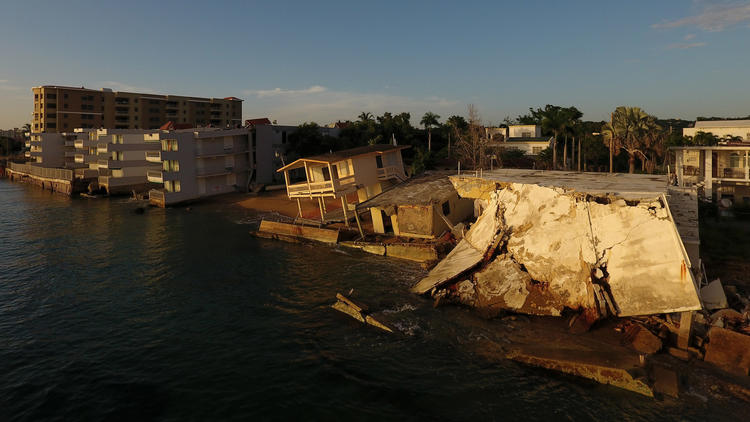RINCÓN, PUERTO RICO — For 16 years, guests at the Tres Sirenas Oceanfront Boutique Hotel could walk down concrete steps from the resort’s deck directly onto Sea Beach, where they lounged on the expanse of sand and took dips in the water.
Then, one year ago, Hurricane Maria struck, bringing surging tides that caused the steps to shatter. The water carried away the sand. The deck collapsed. The coast shrunk. Nearby homes and businesses that overlooked the water crumbled atop the rocks meant to keep out the rising sea.
The beach disappeared.
“My guests used to be able to walk for miles,” said Lisa Masters, who co-owns the hotel with her partner, Wanda Acosta. “If tourists don’t come … then the markets suffer, the maids suffer. … Everybody is affected by it.”
About this series
Hurricane Maria struck Puerto Rico on Sept. 20, 2017, devastating the island’s infrastructure and leaving many without power or access to vital resources. The storm’s death toll was estimated at nearly 3,000, while thousands more have left the island, including many who relocated to Central Florida. The Orlando Sentinel is marking the passage of one year since the storm with a three-part series on key issues still affecting communities on the island.
Part 1: Puerto Rico surf town faces identity crisis – Hurricane Maria stole its beach
Part 2: Puerto Rico’s next hurricane could risk natural water supplies many relied on after Maria
Part 3: A year later, Hurricane Maria’s waste a lingering concern in Puerto Rico
The surf town of Rincón wasn’t the hardest-hit municipality in Puerto Rico. By the time Maria reached the island’s west coast during the early afternoon of Sept. 20, it had weakened to a Category 3 hurricane.
But the storm has hastened Rincón’s steady loss of something fundamental to its community: the beach.
Maria stole the sands on which tourists used to sunbathe and from which surfers used to paddle out into the waves — accelerating the process known as coastal erosion, which had already been slowly eating away at Puerto Rico’s coasts and threatens to reshape the entire identity of oceanside communities like this one.
Erosion causes the coastline to retreat, driven by natural events like sea-level rise, flooding and storms. It usually happens slowly. But Hurricane Maria caused catastrophic losses for about 4 miles of Rincón’s beach — half of its 8-mile coast.
Though all of Puerto Rico’s beaches saw the effects of erosion after Maria to some degree, Rincón’s case is shocking to environmentalists and officials alike.
“We used to play baseball with four bases on those beaches. That doesn’t exist anymore,” said Rincón Mayor Carlos López Bonilla. “I know the entire coastline like my own hands and I watched how with time, we lost those beaches.”
‘We don’t want to be’ on the beach
Hurricane Maria unleashed historic devastation on the island. After the storm hit Sept. 20, 2017, some people here were without communication and went months without running water, power and,in some cases, food. Many have since packed up and left.
Maria reached its peak sustained winds just hours before hitting Puerto Rico’s southeastern coast as a Category 4 hurricane. It remained a major hurricane for days as it barreled through a Caribbean already battered by Hurricane Irma, triggering storm surge warnings as far north as North Carolina and Virginia.
The concept of resilience has taken on a new meaning since the storm. People hear it in the phrase endlessly spouted by island officials and featured on posters and ads for beauty products: “Puerto Rico Se Levanta” — Puerto Rico Rises.
Billboards with another slogan — “Yo no me quito,” which roughly translates to “I’m not giving up” — hang over the island’s highways like reminders for residents during their commutes.
READ MORE AT Sun-sentinel.com

